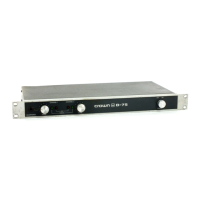~~~~~~
__________
~D~.7~5~PO~
W~E~R
~A~
M
~P~U~A~ER~
__________________
~
RE
~
V~.O
Input Wiring Tips
1. Useonly shieldcdcabl
c:
. Thehlgherthedensity
of
the shield (the oUler conductor). the better the
cabl
e.
Sp
iral
wrapped
shic:ld
is
not
recommended
.
2. K
ee
p unbalanced
cab
les as short
as
possible -
avoid cable lengths greater than 10 fcct. (Long
Wlba.lanced cables
may have noticeable high-
frequency loss and an: at higher risk of pi
ck
ing up
int
erfer
ence
from other
nearby
componenlS.)
3.
00
not run sign
al
cables toge
th
er with high-
level wiring such
as
loudspeaker wires or AC
cords. (This greatly lessens the chance
of
hwn
or
noise being induced
or
picked up from
asymmetrical groWld loops.)
4.
Tum
the enlires),stemoffbeforcchanging any
connections
and
tum
the level controls all the
way
d
own
befor
e
powering
the system back up.
Crown
is
not liable for damage incurred when any
transducer
orcomponent
is
ov
erdriven.
frequencies (and any
unw
anted
DC
Ih
at
ma
y also
be
prese
nt)
, place a capacitor
in
se
ri
es
in
Ih
e i
np
ut sign
al
line. The graph
in
Fi
gure A.2 shows
ho
w
th
e
va
lue
of the
capacitor affects
th
e
frequ
en
cy
r
es
pon
se.
Use
on
ly a low·
leakage
paper, mylar or tantalum capac
it
or.
Fig
. A.2lnpur Hi
gh
Pa
ss
Filter
If
large amounts
of
ultraso
nic
or
RF
(radio
frequ
cncy) are
found
on
lh
e input, such
as
bias
from
tape recorders. etc
.•
place a l
ow
· pass
filt
er on lhe input.
Whil
e
th
e
hi
ghest
RF
levels Ihat c
an
be reason
ab
ly
expected
ma
y not damage
th
e amplifier, they c
an
bum o
ut
tweeters or other sens
it
iv
e
loads,
ac
ti
va
te
th
e amplifier's
pr
Oicctive
system or
overload
th
e controlled-slewi
ng
-rate s
ta
ge
of the a
mp
.
(This la
tt
er amp s
ta
ge prov
id
es
RF
overload protec
ti
on.)
A·2 Appendix A
Th
e following
filt
ers arc reco
mm
e
nd
ed
for such
si
lUati
on
s:
~"
I I
•
-.
.
_
~
.L
-
)@
I .
""'"
•
,--
u_
~
,
.
~..;..
_ • ..
..
.1.
-
- .
"I
) @ . -
,,
-
•
•
,
,
,-
•
~
"
~..;..
..
",
l.
...
"";"
@
"1
"
...
,
-
....
,
..
~
..
---.
-
.....
_
.....
"_
..
Fig.
A.3
RFJ
(Lowpass)
Filter
••
•
,.
~
An
other problem
to
pre
ve
nt
is
gro
und
loops - undesirable
c
urr
ents no
wing
in a gro
und
ed
system, possibly caus
in
g
hum
in
the output. A
co
mm
on
form
of
loop is a pair
of
input cables w
ho
se
area
is s
ubj
ected to a magnetic
hum
field. To prevent ground loops caus
in
g
magn
etic
ind
uction, lace both cables
to
ge
th
er
al
ong
th
eir length,
and away
fro
m the power
tran
s
form
e
r.
DO
NOT
CONNECT
TH
E INPlIT
AND
OlITPUTGROUNDS
TOGETHER.
Ye
t ano
th
er
fac
et of t
hi
s problem occurs
whe
n
in
put and
output grounds, tied together
as
in
testing or metering,
allow
feedba
ck osc
ill
ati
on
from
load curre
nt
flowing
in
the
loop.
In
some systems, even
th
e
AC
power
lin
e
ma
y
provide
thi
s feedback path. Proper grounding, isolation of
inputs a
nd
co
mm
on AC·line devices is good practic
e.
A.4 Output
Co
nsider the power handling capacity
of
yo
ur
load before
co
nnecting
it
to
the
amplifier. Crown is not
li
able for
damage incu
rr
ed
at any transducer
du
e LO its being
overpowered.
Th
e use of loudspeaker
pr
otection fuses is
h
ig
hly r
ecom
mended (sec
Sec
ti
on
3.3.4). Please also
pay
dose
auention to the Operating Prcxautions
sec
tion
(
Scc
Li
o
n4
.1).
Un
der nonnal stereo
co
nditions, a l
oa
d impedance less
than four o
hm
s sh
ou
ld not
be
used. The m
on
itor
ou
tp
ut
is
parallel
10
th
e
ma
in
ou
tpu
ts
so any l
oad
co
nn
ected
to
it
,
such
as headphones, will affect
th
e load impedan
ce.
Be
careful wh
en
wi
rin
g multiple tran
sd
ucers to a channel.
(fwo
g·o
hm
speakers
in
parallel present
an
impedance
of
4 o
hm
s
whi
le
th
e same
two
speakers
in
series
hav
e a
16
o
hm
impedance.)

